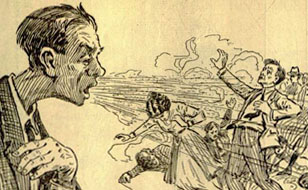WWI: North Carolina and Influenza
See also: Public Health; Infectious Diseases; Influenza outbreak of 1918-1919
Germany was not the only enemy North Carolinians faced during World War I. A silent foe stalked both soldier and civilian alike and slaughtered some twenty million people worldwide before it finally retreated. This enemy was a new strain of influenza nicknamed the “Spanish Lady” The name came from a rumor that the disease had started in Spain.
Influenza killed almost 500,000 Americans—ten times the number of American soldiers who died in combat during the war. American troop ships returning home with sick soldiers brought the flu to the home front. In a single week in October 1918, an estimated 21,000 Americans died. In North Carolina 13,644 people died before the epidemic finally went away. During its peak in October and November, there were only two kinds of people in the state—those who were sick with influenza and those who were trying to save them.
The illness sometimes lasted seven to ten days. It hit suddenly with chills, a high fever, upset stomach, weakness, and other symptoms. It continued until the patient either recovered or died. Influenza struck without regard to class and race, but the majority of victims were young adults between the ages of twenty and forty. Pregnant women had an especially hard time. Each day local newspapers listed names of citizens who had died since the last issue.
Mrs. C. R. Hudson lived near Oakwood Cemetery in Raleigh and recalled that “they died so fast they could not have proper burials. They couldn't dig graves fast enough.” Dr. W. S. Rankin, secretary of the State Board of Health, recruited doctors and nurses for communities especially hard hit by influenza. The epidemic spread so rapidly that health officials often could not do much except offer advice through newspaper columns and health pamphlets.
Influenza spread when people were in close contact, so local health officers moved swiftly to close public schools and colleges, churches, theaters, fairs, and dance halls. Stores, textile mills, and other businesses also closed. Employees were either sick, afraid of getting sick, or at home taking care of the sick. Tar Heel communities looked like western ghost towns as residents remained inside their homes.
Few communities escaped the epidemic, and even fewer had the resources to care for the sick. Hospitals were not large enough to handle all the patients, so temporary hospitals opened in churches, schools, and armories. Doctors could not answer all of the calls of those affected, especially in farming communities. Many trained nurses had left to care for wounded soldiers, so communities often had to rely on women serving as volunteer nurses. Women also opened nurseries to care for the children of families stricken with influenza and labored in food kitchens to feed the children of the poor. Although the disease crossed all the lines of class and race, segregation policies required separate care for African-American and white victims. Still, white communities readily accepted the services of black nurses to care for their patients.
By the close of 1918, the worst months of the epidemic had passed. North Carolina soldiers in France had carefully followed reports of the flu at home through letters and newspapers. Many soldiers who faced death daily at the front mourned relatives who had died an ocean away from the war.
The citizens of Raleigh believed that those who had served as volunteers should be properly recognized for their work. These men and women had labored tirelessly in caring for others, and some had become ill and died as a result. In the early 1920s, a monument was put up on the Wake County Courthouse grounds in Raleigh. It honored those who had given their lives caring for others during the epidemic of 1918.
At the time of this article’s publication, Tom Belton served as curator of militaria, politics, and society for the North Carolina Museum of History. Belton previously served as executive secretary of the Tar Heel Junior Historian Association.
Additional resources:
Cameron, Annie Sutton. 1919. A record of the war activities in Orange County, North Carolina. 1917-1919. Call #566. Manuscripts Dept. Southern Historical Collection, UNC-Chapel Hill. https://docsouth.unc.edu/wwi/cameron/cameron.html
Cockrell, David L. 1996. "'A blessing in disguise': The influenza pandemic of 1918 and North Carolina's medical and public health communities." North Carolina Historical Review 73(3): 309-27. (At your library)
The deadly virus: The influenza epidemic of 1918. National Archives and Records Administration. http://www.archives.gov/exhibits/influenza-epidemic/
Google Flu Trends. http://www.google.org/flutrends/
North Carolina. The great pandemic: The United States in 1918-1919. United States Department of Health and Human Services. http://1918.pandemicflu.gov/your_state/north_carolina.htm
North Carolina and the "Blue Death": The flu epidemic of 1918. ANCHOR. https://www.ncpedia.org/anchor/north-carolina-and-blue
Influenza 1918. American Experience series, PBS. http://www.pbs.org/wgbh/americanexperience/films/influenza/
Influenza digital archive. University of Michigan Medical School. http://www.uofmhealth.org/node/660263
Influenza documents from the NC Digital Collections.
Taubenberger, Jeffrey K. and David Morens. 2006. "1918 influenza: The mother of all pandemics." Emerging Infectious Diseases. http://www.cdc.gov/ncidod/EID/vol12no01/05-0979.htm
Image credit:
Detail from "The way North Carolinians do it at home." October 1919. The Health Bulletin, Vol 34, Issue 10. https://digital.ncdcr.gov/Documents/Detail/health-bulletin-1919-1920-v.34/1952312
1 May 1993 | Belton, Tom
